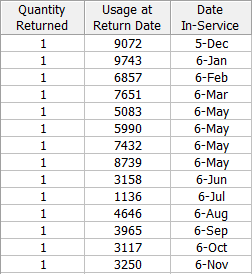Template:Usage format: Difference between revisions
| Line 8: | Line 8: | ||
[[Image:monthsquantity.png|thumb|center|400px| ]] | [[Image:monthsquantity.png|thumb|center|400px| ]] | ||
Note that, like in the dates of failure format, in order to identify which lot the unit comes from, a failure is identified by the return number and the date of when it was put in service. The date that the returned unit went into service associates the returned unit with the lot it belonged to when it started operation. However, the return data is in terms of usage and not date of return. Therefore the usage of the units needs to be specified as a constant usage per unit time or as a distribution. This allows determining the expected usage of the surviving units (See Example | Note that, like in the dates of failure format, in order to identify which lot the unit comes from, a failure is identified by the return number and the date of when it was put in service. The date that the returned unit went into service associates the returned unit with the lot it belonged to when it started operation. However, the return data is in terms of usage and not date of return. Therefore the usage of the units needs to be specified as a constant usage per unit time or as a distribution. This allows determining the expected usage of the surviving units (See [[Warranty Analysis Usage Format Example|Example 2]]). | ||
Revision as of 21:22, 21 February 2012
Usage Format
Often the driving factor for reliability is usage rather than time. For example, in the automotive industry, the failure behavior in the majority of the products is mileage-dependent rather than time-dependent. This format allows specifying Quantity In-Service Data, and the usage at return date and Quantity Return Data, as illustrated in the following tables.
Note that, like in the dates of failure format, in order to identify which lot the unit comes from, a failure is identified by the return number and the date of when it was put in service. The date that the returned unit went into service associates the returned unit with the lot it belonged to when it started operation. However, the return data is in terms of usage and not date of return. Therefore the usage of the units needs to be specified as a constant usage per unit time or as a distribution. This allows determining the expected usage of the surviving units (See Example 2).

